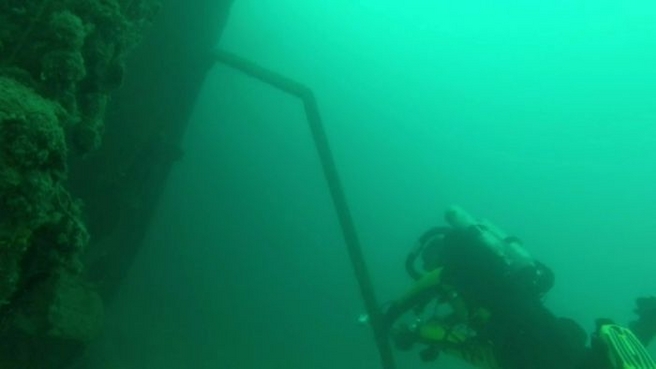News
Australian WWII warship grave HMAS Perth stripped by salvagers

Survivors, historians and Defence personnel have been horrified to discover that the wreck of HMAS Perth, which was sunk by the Japanese in 1942, is being destroyed by commercial salvagers in Indonesian waters.
Australian authorities have tried to keep the scandal a secret, fearing the issue might add fuel to the ongoing diplomatic tensions between Australia and Indonesia.
The warship, which sank in the Sunda Strait between Sumatra and Java, is the last resting place of as many as 355 Australian sailors who went down with the vessel after it was struck by multiple torpedoes.
But it has never been protected as an official war grave.
Australia and Indonesia are yet to ratify the UNESCO Convention on Underwater Cultural Heritage, a binding national treaty which would oblige both countries to protect such sites.
Since at least September, scuba divers have made official reports of large-scale damage to the wreck from a massive floating crane equipped with a salvage claw.
These reports have been made to the Australian embassy in Jakarta and to local officials in the Department of Environment and Heritage, and the Department of Defence.
Several salvage barges have been spotted in the area, and one was photographed in October dredging up the carcass of a Dutch submarine – the O-16 – which sank off the coast of Malaysia.
Sam Collett, a professional diver based in the Philippines, told reporters he last visited the wreck in September.
“Compared to previous trips I had made, the extent of commercial-scale salvaging was immediately obvious,” he said.
“On the boat trip back to the marina in Anyer we passed a salvage barge with a crane and claw and a large pile of what appeared to be wreckage on the deck.”
Andrew Fock, an expedition diver with a keen interest in HMAS Perth, said there was “extensive damage”.
“As best we can tell from the video footage supplied, most of the superstructure – if not all of it – is gone, the guns from the forward turret, the A-turret are missing.
“The gun houses for the two front turrets are missing, and most of the upper deck… is missing.
“The catapult has been removed, the bridge has been removed, the crane has been removed.”
An official report was lodged with the Department of Defence in October detailing the damage. The report said there was a strong possibility that human remains still exist within sections of the ship and that they risk being disturbed.
It warned action must be urgently taken to prevent further mass salvaging.
“It is probable that unless action is taken the salvers will return and continue to pull apart the wreck, especially if their previous efforts have been remunerative,” the document said.
“It should be noted that any attempt to remove the exposed starboard armour belt would likely involve its supporting structure and prove catastrophic to the integrity of the remaining hull structure.”
There have been other reports of the use of explosives by salvagers to break up the ship and make it easier to dredge.
In September, an Indonesian-based diver wrote: “The mid section above deck, where the bridge was, has been completely removed, the bow guns have been damaged by what appears to be explosives with the barrels missing and the tops peeled of [sic], the bow has collapsed completely.”
“Although it is hard to be certain, but as the metal that was the superstructure is all missing and is not lying around as debris it looks although we could be wrong like purposeful attempt to salvage the steel.”
The Defence report also made specific mention of risks posed by the fuel oil and ordnance on board the Perth.
The Indonesian-based diver did a second dive in September to confirm his findings. In an email, he reported that the vessel is now too “unstable” to allow divers to penetrate the interior of the ship.
“She has been hammered and the once impressive six inch A1 and A2 turrets are gone, the bow is flat and… the wreck is more hazardous than before – even for general swimming around, with lots of live ordinance, wire and overhanging metal.”
“The explosions have unearthed a fair amount of WW2 live rounds and what look like modern explosives (plastic flare shaped things) I assume from the salvage also appear to be lying about, be very careful what you poke in the sand/silt.”
To read more on this story, click here.
Source: www.au.news.yahoo.com
News
Book Review: Fire on Monroe Bravo by Fred Lockwood

Fire on Monroe Bravo is the latest book in the Jack Collier series by Fred Lockwood. Our story begins with our lead characters, Jack and Sandro, owners of Marine Salvage & Investigation Company, arriving on the Monroe Bravo Oil & Gas Platform in the North Sea. Having secured a contract for their vessel the MV Stavanger to act as support ship to the platform for TransGlobal Oil, our protagonists are on a celebratory visit.
However almost as soon as they arrive a series of explosions rock the platform, causing huge damage, loss of life and the very real danger of a massive human, ecological and financial disaster.

As the danger mounts for both our heroes and the surviving workers, Jack and Sandro will have to escape the inferno, all while trying to save the platform and the men still trapped unable to help themselves.
The disaster sets the scene for the unfolding story lines following the fate of the platform and our main characters, the police investigation into a suspected terrorist act and the actions of TransGlobal Oil as they attempt to navigate the pubic outcry and financial repercussions.
In his eighth book, Fire on Monroe Bravo, Fred Lockwood delivers an explosive thriller, with plenty of above and in-water drama, and our heroes fighting for survival, what more can you ask for?
We thoroughly recommend this read and look forward to the next in the series. For more information about his book series, you can check out the reviews of his previous books here on Scubaverse.
- Title: Fire On Monroe Bravo
- Author: Fred Lockwood
- ISBN: 979-8325324536
Available in a paperback version and for Kindle from Amazon and book stores.
Blogs
Alonissos: The complete diving destination (Part 1)

In June we were incredibly fortunate to be invited to dive in Alonissos, a small Greek Island in the Sporades island chain located in the North Aegean Sea. While I have long been a big fan of the Greek Islands as a great holiday destination, I had not had the opportunity to do any diving on previous visits and Mike and I were extremely excited to see what Alonissos had to offer both above and below the surface!

The Sporades are easily accessible via the airport in Skiathos (the first island in the chain), which is served by Jet2 flights from all major UK airports from May through October. Numerous ferries and charter boats make island hopping from Skiathos Town a breeze. After an hour boat ride, the picturesque port of Patitiri was a wonderful introduction to Alonissos, where we were met by our gracious hosts Kostas of Albedo Travel and Dias of Alonissos Triton Dive Center. Mike and I were delighted to be staying at the Paradise Hotel, aptly named for its stunning views over the sea and great location for walking to the waterfront.

Alonissos is beautifully situated in the National Marine Park of Alonissos and the Northern Sporades, the largest marine protected area in Europe. The surrounding seas offer fabulous marine life, including incredibly rare species such as the Mediterranean monk seal. They boast deep walls covered in gorgonians and sponges, stunning topography with caverns, swimthroughs and pinnacles, and the first accessible ancient shipwreck from 500BC!

In locations where historical sites have been reported, the waters are largely restricted, but with collaboration between government, underwater archeologists and dive centres, incredible underwater museums are being created for a truly unique diving experience. Alonissos is home to the first of these, the Ancient Shipwreck of Peristera Accessible Underwater Archeological Site. The chance to dive into history (along with reports of healthy reef life and amazing underwater topography) meant Mike and I were keen to get in the water.

Our introduction to the diving around Alonissos was at the Agios Georgios Pinnacles, in the channel between Alonissos and Skopelos. This fantastic site was named “The Chimney,’ and proved to have a huge amount to see. We got to a decent depth here (over 25m), and marvelled at a colourful reef wall with a wonderful swim through whose rocky walls were absolutely covered with life. As well as brilliant topography there was no shortage of macro life here. We saw numerous nudibranchs, five different species in total. The second dive at Mourtias reef nearby was a shallower dive along a nice wall with lots of crevices. Several moray eels and grouper called this site home. We enjoyed looking in the crevices for lobster and smaller benthic life, such as cup corals and tunicates.

Our itinerary allowed us two dives a day with afternoons left to explore the island with our hire car and evenings to enjoy the famous Greek hospitality. This proved to be a lovely mix of in-water and land based diversions.

The next days diving to the Gorgonian Gardens and Triton’s Cave was to be even better! These two stunning sites are nothing short of fabulous. The Gorgonian Gardens was a deep wall near to the Agios Georgios islands. The ever-present currents in this deep channel meant that the sea life was amazing … the namesake Gorgonian sea fans dotted the wall at a depth of 30 to 50 meters, getting ever larger the deeper we went. Above 30m was by no means less beautiful, with sponges, corals, scorpionfish, moray eels and some rare and colourful nudibranchs.

The second shallower dive of the day was to Triton’s Cave or the Cavern of Skopelos, on the east side of that island. The spectacular rock formations had wild striations both above and below the water making a truly epic topography. The cavern entrance was at 14m, and big enough for a buddy pair, winding up to 6m and passing two beautiful windows out into the blue. Emerging from the cavern, the light at the shallower depths and the incredible rock formations made for a fantastic gentle swimming safety stop and we all surfaced by the boat with massive grins.

Check out our next blog :Alonissos: The complete diving destination (Part 2)” to hear about our amazing dive on the 2500 year old Peristera Wreck!
Thanks to:
Alonissos Triton Dive Center https://bestdivingingreece.com/
Albedo Travel https://alonissosholidays.com/activities/
Paradise Hotel https://paradise-hotel.gr/
Alonissos Municipality https://alonissos.gr/en/
-

 Blogs2 months ago
Blogs2 months agoDiving With… Nico, Ocean Earth Travels, Indonesia
-

 News1 month ago
News1 month agoMurex Bangka Announce New Oceanfront Cottages & Beachfront Dining
-

 Blogs2 months ago
Blogs2 months agoA new idea in freediving from RAID
-

 Marine Life & Conservation1 month ago
Marine Life & Conservation1 month agoIceland issue millionaire whale hunter a licence to murder 128 vulnerable fin whales
-

 Marine Life & Conservation2 months ago
Marine Life & Conservation2 months agoThe Shark Trust Great Shark Snapshot is back
-

 News3 months ago
News3 months agoCharting New Waters; NovoScuba Goes Global with the Launch of their Revolutionary Dive Training Agency!
-

 Gear News1 month ago
Gear News1 month agoNew Suunto Ocean – a dive computer and GPS sports watch in one for adventures below and above the surface
-

 Marine Life & Conservation Blogs2 months ago
Marine Life & Conservation Blogs2 months agoBook Review: Plankton















